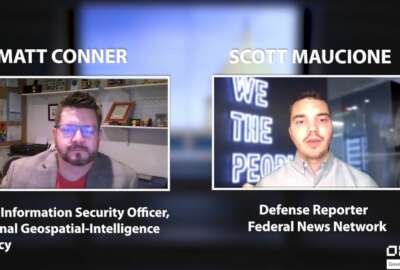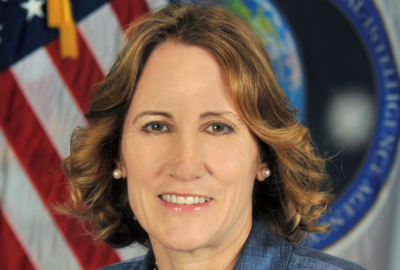A new commercial strategy for the National Geospatial Intelligence Agency
The National Geospatial Intelligence Agency is revising its approach to using commercial sources of technology and data. It wants to diversify its sources, impr...
Best listening experience is on Chrome, Firefox or Safari. Subscribe to Federal Drive’s daily audio interviews on Apple Podcasts or PodcastOne.
The National Geospatial Intelligence Agency is revising its approach to using commercial sources of technology and data. It wants to diversify its sources, improve data security, and maybe have some influence on what the GEOINT industry does. For details, the Federal Drive with Tom Temin turned to the NGA’s associate director for enterprise, Gary Dunow.
Interview transcript:
Tom Temin: Mr. Dunow, good to have you on.
Gary Dunow: Thanks, Tom. It’s good to be on your show.
Tom Temin: And my understanding is that the NGA has been using commercial data sources since there are so many satellites now and whatever drones, balloons looking down on the Earth, what’s the new strategy? What are you trying to accomplish here?
Gary Dunow: Yeah, that’s correct, Tom, we’ve been using commercial source providers for over a decade now. And it’s part of our standard processes. The intent with this new strategy, which was released by Adm. Sharp just a few months ago, on Nov. 4, is to try to bring the entire GEOINT community so broader than just NGA. Your listeners may not be aware, but many leaders in the intelligence community wear multiple hats. In the case of Adm. Sharp, he’s not only the director of our agency, but he’s also what’s referred to as the GEOINT functional manager, and has the responsibility to try to bring together the entire community that does GEOINT within the intelligence community in the Department of Defense, and make sure that we’re being good stewards of taxpayer dollars. And using these capabilities efficiently and effectively.
In the case of commercial imagery providers, it’s sort of a unique capability within the intelligence community and DoD because it is a commercial commodity. And anyone can go out and purchase the capabilities that are provided by the really expanding number of businesses that are entering the commercial imagery world. And so the strategy is an attempt for us to put on paper how the director would like us to pull the community together to make sure that as we enter contracts, look at new capabilities, we’re doing it in a way that’s efficient and effective. And we’re not unnecessarily duplicating purchases, or duplicating capabilities that might already exist. So really getting after the unity of effort approach to the first tenet of the strategy.
Tom Temin: So for example, the Navy might have its own GEOINT capabilities, and some of the intelligence agencies have their own, the armed services to boot. And you want to make sure there’s a uniform approach so that the government looks like one customer in effect to the GEOINT industry.
Gary Dunow: That’s correct. Like I had mentioned, we really want to make sure we’re being good stewards of taxpayer dollars. And commercial imagery and commercial services can be used in a variety of different organizations in a number of different ways. And so we want to really create some transparency into where those purchases are happening, and have conversations with other members of the community, as well as the industry partners about how we license those capabilities to make sure that government isn’t spending money twice for the same capabilities.
Tom Temin: Now, from the vendor standpoint, I imagine that they would want to sell some to NGA sell to the Navy sell to the Coast Guard sell to even Homeland Security, I guess I’m presuming is also part of this, you know, via the Coast Guard and maybe some other components there. So how do you convince them that to sell once, where right now they might be able to have the opportunity to sell eight times?
Gary Dunow: So we work really closely with our partners over at the National Reconnaissance Office who have the responsibility for the commercial imagery acquisition right now, to have the right conversations with industry partners about how we write the contracts and the licensing agreements that support those contracts, to make sure that we are supportive of the U.S. commercial industry. Because across the board, we want to make sure that we have a thriving, very robust domestic commercial capability, while we also balance that stewardship of taxpayer dollars. And so it’s a bit of a negotiation to make sure that we do this right. But in my experience, our industry partners are very good at recognizing their contributions to national security through this effort, and having the right perspective on how they approach this business sector, as opposed to maybe some of the other sectors and they do have opportunities on the global stage to market to other nations and other entities around the world to make sure that they’re viable businesses.
Tom Temin: We’re speaking with Gary Dunow, he is the associate director for enterprise at the National Geospatial Intelligence Agency. And besides data, the memorandum that was expressed by Adm. Sharp mentioned adapting architectures and processes that are oriented more commercially, perhaps and so that gets beyond the data into maybe other strategies. Talk about those a little bit.
Gary Dunow: Yeah, that’s a key factor of this new enterprise commercial GEOINT strategy is making sure that we’re being efficient and effective with resources when it comes to architecture, policies and processes as well, because you’re right, it’s not just the data that might be purchased multiple times. But if we’re buying that data, and then using it on different architectures where it’s not shareable with those that it’s able to be shared with based on those licenses and contract agreements, then we aren’t being efficient. And we’re not meeting the speed of need for our warfighters, our decision makers and our policy makers who use that data on a regular basis. And so we’re initiating conversations through the strategy about how that architecture is built out, how we might move away from, for example, a pretty strong reliance right now on the data itself, the images, and drive industry towards a construct where we’re getting services that are informed by the imagery rather than the imagery itself, because it does take a long time to move that imagery around, look at it, assess it, analyze it, and then make the assessments or decisions that are needed based on the data. In cases like, for example, in the commercial world, there’s good capabilities where some of the partners are looking at, for example, parking lots to determine high business hours for different entities, and then taking differences in those parking lot capacity rates and determining investment opportunities for those businesses. So we call that change detection. So we’re looking at rather than getting the images ourselves, could we have some sort of service that provides a change detection that makes things faster and easier for our analysts and our consumers.
Tom Temin: But isn’t a lot of that analysis and interpretation and projection of this type of imagery, really part of the NGA secret sauce? And so how do you maintain the national security advantage that you need when the vendors of data are getting higher and higher, and I guess you’d call it the food chain of being able to use the imagery?
Gary Dunow: Yeah, there’s a wide spectrum of analytic effort that goes into the assessments that we provide. And the example I used about the parking lot capacity is something that we have seen through industry, that the machines can be taught how to make those assessments with a pretty high accuracy rate. A lot of the other work we do is really not transferable to machines at this time, although there’s a lot of work going on across the community, in the artificial intelligence machine learning realm, to see what could be done, with the right amount of confidence, to allow us to let the machines do what machines do best, and then let the human analyst to do what the human analyst does best. There is also enough data coming through our analyst enterprise, that we could use machines to help prioritize some of the work that’s being done so that the analysts can look at some of the higher priority things to make sure we’re putting eyes on and getting completely accurate assessments based on the expertise that those analysts who are highly trained and highly skilled bring to the table.
Tom Temin: And they might also be integrating other data sources not available to the vendor. And doing that in a way that gives the, let’s call it strategic offset to the NGA, that would not be available anywhere else.
Gary Dunow: That’s correct. Can’t go into a lot of detail, obviously. But of course, our analysts look at a variety of information from a variety of sources. Commercial imagery is one key piece of that. And we want to make sure we’re using the commercial imagery capabilities for the right things at the right security level, to provide the right assessments where it can provide a complete assessment by itself, but also contributions to other assessments, where those multiple sources provide greater fidelity and greater clarity of information for our customers.
Tom Temin: And would it also be accurate to say that even with all of the commercial data and technology coming into NGA, into the national security establishment, as you’ve described, that there are still sources of imagery that are exclusive to NGA, and will remain so because of national security purposes?
Gary Dunow: Yes, that is the case. Again, we have some really good partners in the community that provide capabilities for us that go above and beyond what the commercial community can currently provide. Although the commercial industry is really expanding pretty quickly with different phenomenologies and different capabilities. So it’s a really good complement across the board for the national security enterprise.
Tom Temin: Yeah, but the more and more they launched dozens and scores of cube sats, the better they get, I guess.
Gary Dunow: They are constantly making improvements, both in the amount of access they have because of the numbers of satellites they’re launching. And also, in some cases, as I mentioned, phenomenology and the resolution of some of the satellites that they’re putting up.
Tom Temin: And finally, what about data security and mitigation of risk? Because that was also mentioned in the strategy that Adm. Sharp outlined.
Gary Dunow: Yeah, Tom. So you know, we consider the commercial industry key partner within the GEOINT enterprise and we believe that taken an enterprise approach is the right approach, because then we maximize the strengths of everyone who’s contributing to it. But at the same time, the enterprise is only as secure as the weakest member of the enterprise. And not defining who that is right now just a general concept. So we want to make sure as we connect the enterprise for different sources of information and data to help make our analysis stronger and better, that conductivity touches just about everything that we do. And so we look at things like cyber attacks that have happened in the past by different nation states, and the fact that our adversaries have demonstrated capability to breach our nation in cyberspace. And we’ve done a lot of work through our technology efforts here within NGA, but also across the community with our partners there to make sure we’re putting the protections in place as we connect different members of the enterprise to make sure our vulnerabilities are minimized. So there are things that we’re doing along with other partners like looking at the president’s Executive Order 14028 to improve cybersecurity with zero trust, guiding NGA’s cybersecurity standards, and working with the DoD and EIC to leverage the best capabilities that are available.
Tom Temin: Gary Dunow is the associate director for enterprise at the National Geospatial Intelligence Agency. Thanks so much for joining me.
Gary Dunow: Thanks for having me, Tom.
Copyright © 2024 Federal News Network. All rights reserved. This website is not intended for users located within the European Economic Area.
Tom Temin is host of the Federal Drive and has been providing insight on federal technology and management issues for more than 30 years.
Follow @tteminWFED






